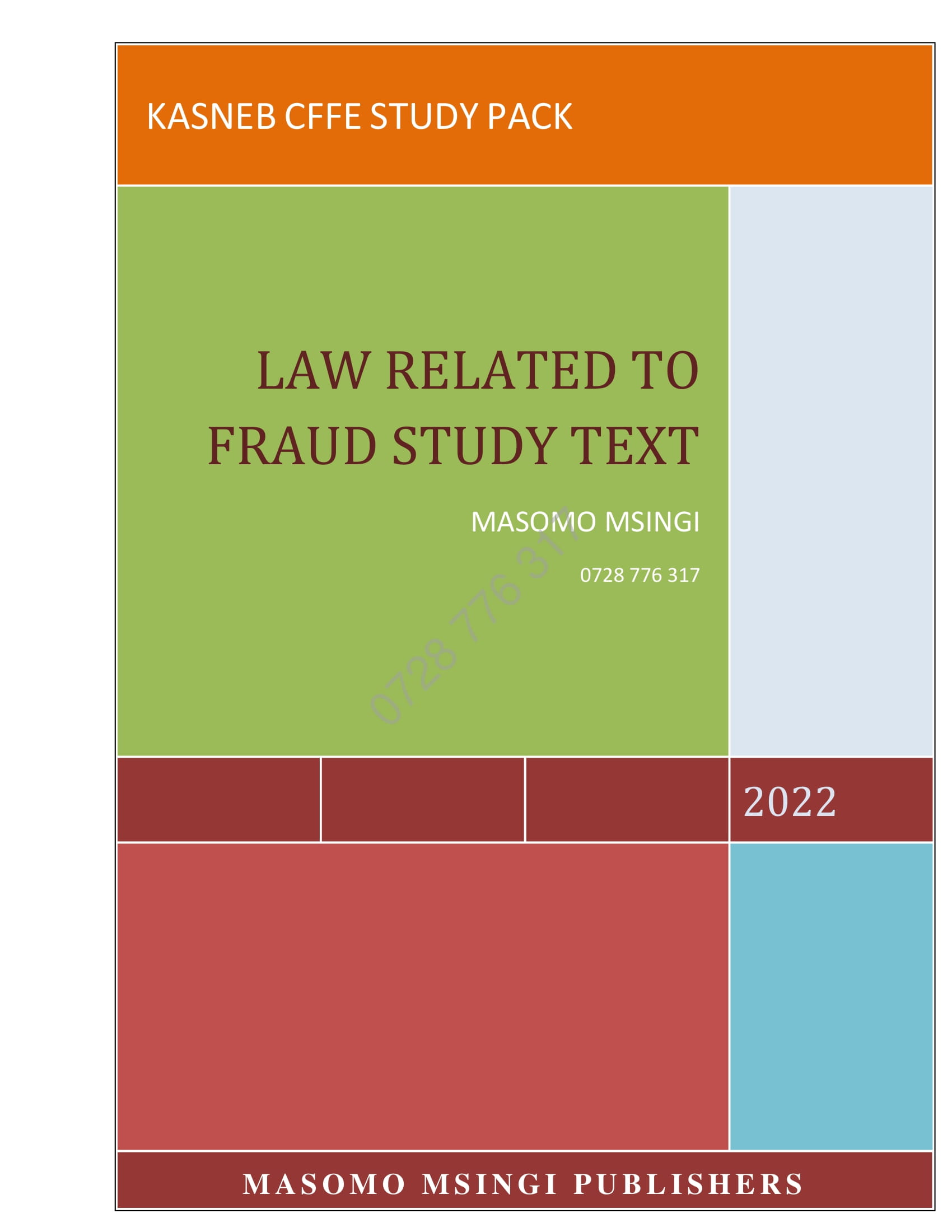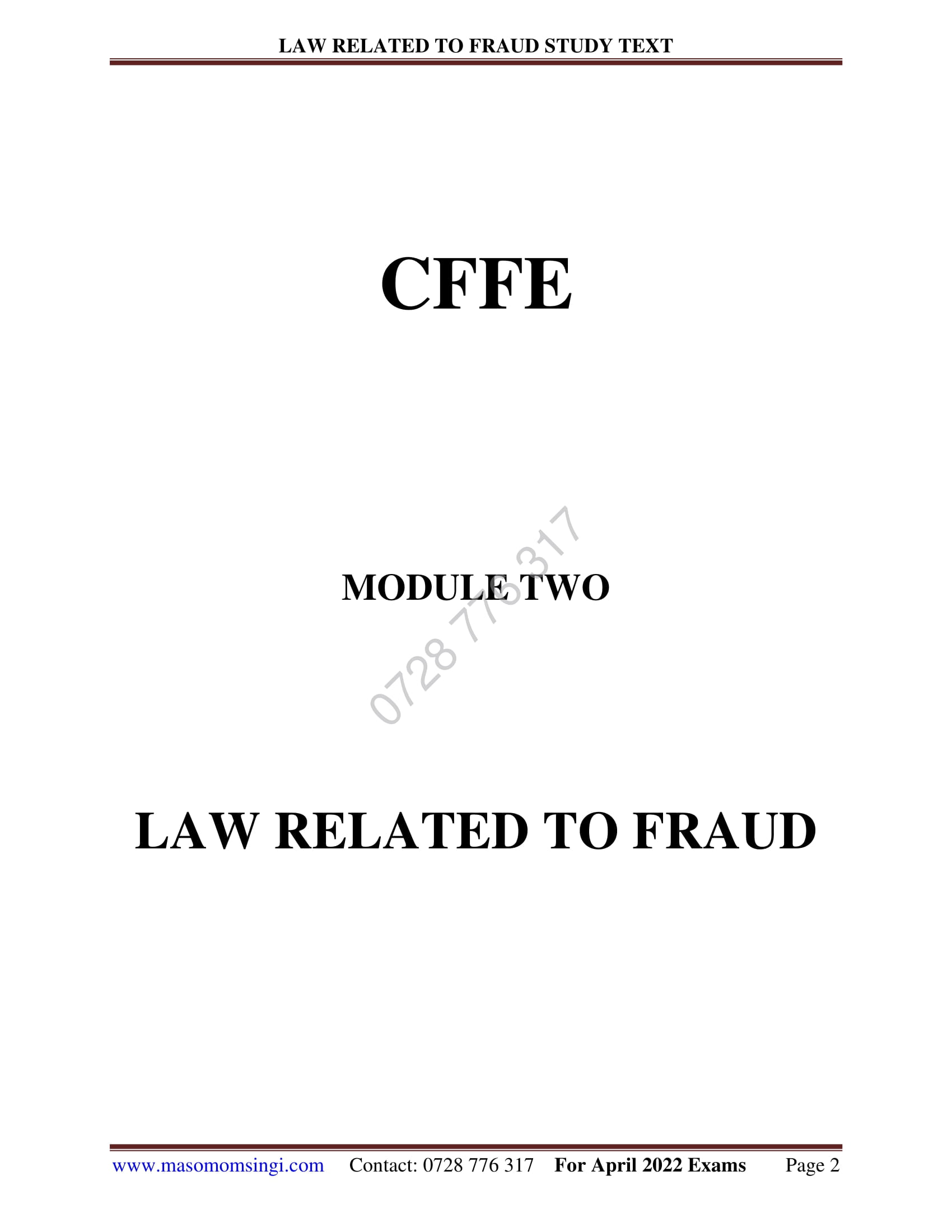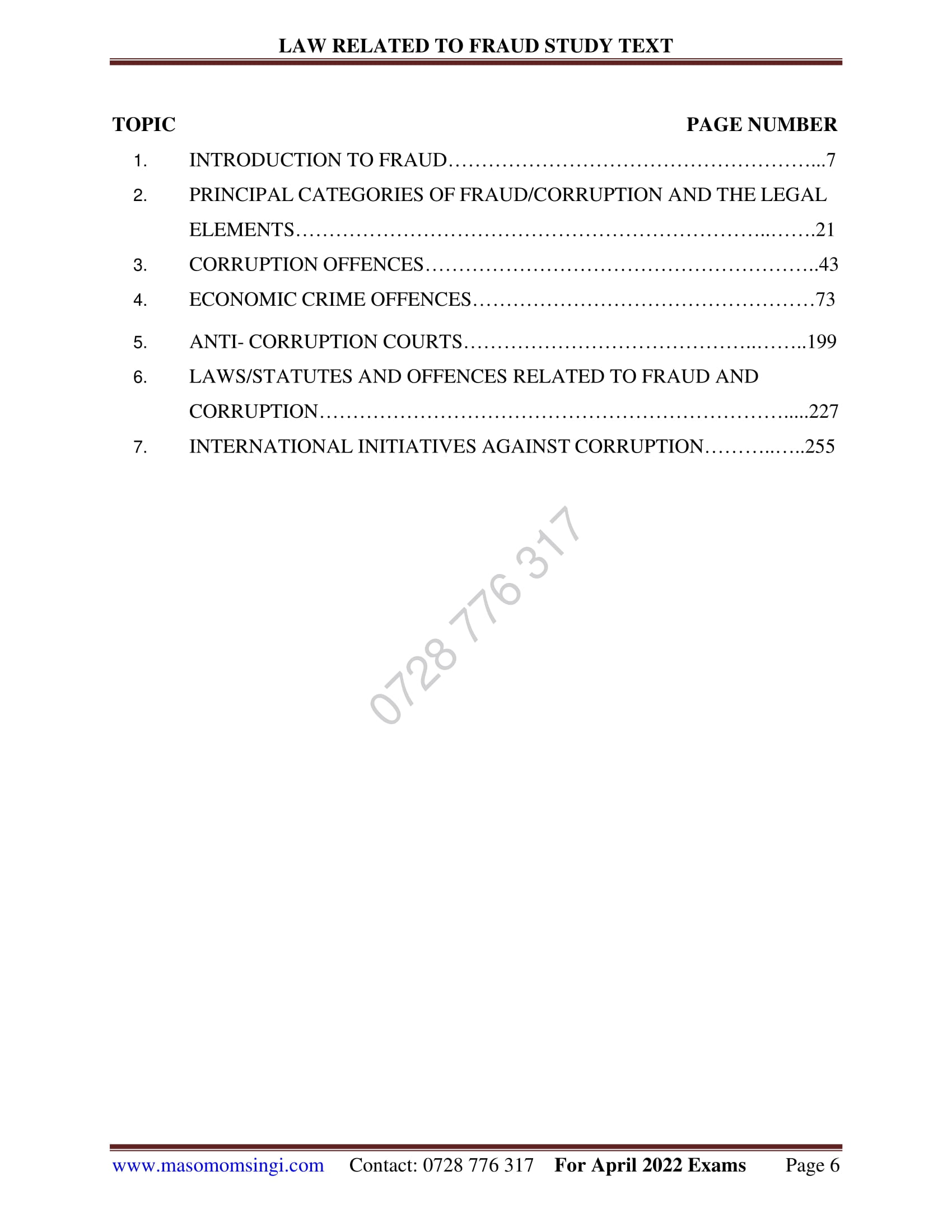MASOMO MSINGI PUBLISHERS APP – Click to download and Access all our materials in PDF

SAMPLE WORK
Complete copy of Law Related To Fraud Revised KASNEB Notes is available in SOFT ( Reading using our MASOMO MSINGI PUBLISHERS APP) and in hard copy
Phone: 0728 776 317
Email: info@masomomsingi.com

INTRODUCTION
Following our continued effort to provide quality study and revision materials at an affordable price for the private students who study on their own, full time and part time students, we partnered with other team of professionals to make this possible.
Special appreciation and recognition to the lecturers who have helped in the development of our materials, These are: FA Kegicha William Momanyi (MBA Accounting, CPA, CISA and CCP), FA Bramwel Omogo (B.sc Actuarial Science, CIFA, CIIA, CFA first level and ICIFA member, Johnmark Mwangi (MSc Finance, CPAK, BCom Finance),CPA Gregory Mailu (Bsc. Economics) CPA Dominic Rasungu and CPA Lawrence Ambunya among others.
PAPER NO.4 LAW RELATED TO FRAUD
UNIT DESCRIPTION
This paper is intended to equip the candidate with knowledge, skills and attitudes that will enable him/her to apply the laws related to fraud and investigations.
LEARNING OUTCOMES
A candidate who passes this paper should be able to:
- Apply the various laws related to fraud and corruption
- Identify the various fraudulent, corrupt and white collar offences as defined as by the law
- Explore the relationship between fraud and corruption
- Classify fraud/corruption schemes into legal categories and the related legal elements
CONTENT
- Introduction to fraud
- Legal definition of corruption, fraud and white collar crime
- Perpetrators of fraud/corruption and white collar crime
- Social and economic effects of fraud and corruption
- Legal and justice challenges of fraud and corruption
2. Principal categories of fraud/corruption and the legal elements
- Fraudulent misrepresentation of material facts (false pretences)
- Negligent misrepresentation
- Concealment of material facts
- Bribery
- Illegal gratuity
- Economic extortion
- Conflict of interest
- Forgery
- Theft of money or property
- Breach of Contract
- Breach of fiduciary duty
- Gross negligence
- Conspiracy
- Obstruction of justice
- Perjury
- False claims and statements to government or government agencies
3. Corruption offences
- Bribery/ kickbacks
- Conflict of interest
- Abuse of office
4. Economic crime offences
- Money Laundering and Terrorist Financing
- Abuse of office
- Tax Evasion
- Bankruptcy/Insolvency Fraud
- Securities Fraud
5. Anti- corruption courts
- Parties in Anti-Corruption Court
- Fraud and corruption criminal trials
- Fraud and corruption civil trials
6. Laws/Statutes and offences related to fraud and corruption
- Penal Code
- Anti-Corruption and Economic Crimes Act
- Leadership and Integrity Act
- Bribery Act 2016
- Public Procurement and Assets Disposal Act 2015
- Proceeds of Crime and Anti Money Laundering Act (POCAMLA) and Regulations
- Controller of Budget Act
- Public Finance Management Act
- Leadership and Integrity Act
- Tax Act
- Securities Act and Regulations
7. International initiatives against corruption
- Organisation of Economic Corporation Development
- United Nations Convention

CHAPTER ONE
INTRODUCTION TO FRAUD
Fraud is a broad term that refers to acts intended to swindle someone. In essence, it’s the use of intentional deception for monetary or personal gain.
Thousands of people each year fall victim to it. Fraud always includes a false statement, misrepresentation or deceitful conduct. The purpose is to gain something of value, usually money, by misleading or deceiving someone into believing something that the perpetrator knows to be false.
What the Law Says About Fraud
Fraud is covered by both criminal and civil laws. The most obvious difference has to do with who files the legal case. Only government prosecutors can bring criminal charges, but a victim of fraud can file a civil lawsuit. Sometimes a person who commits fraud is both criminally prosecuted and sued in a civil action.
In the criminal context, fraud must be proved “beyond a reasonable doubt.” If convicted of the crime, a defendant may be sentenced to jail or probation and fines.
In private civil lawsuits, the standard of proof is lower and punishment is often restitution (i.e., return of the victim’s money) and monetary damages. When regulators such as the Federal Trade Commission or Securities and Exchange Commission file civil lawsuits against unscrupulous businesses, they frequently seek injunctions, restitution to victims and monetary penalties.
While the exact wording of fraud laws varies, the main elements usually are:
- a purposeful misrepresentation of an important (“material”) fact;
- with knowledge that it is false;
- to a victim who justifiably relies on the misrepresentation; and
- who suffers actual loss as a result.
Types of Fraud
Common varieties of fraud offenses include:
- Identity theft
- Insurance fraud
- Mail fraud
- Credit/debit card fraud
- Securities fraud
- Telemarketing fraud
- Wire fraud
- Bankruptcy fraud
- Tax evasion
SAMPLE WORK
Complete copy of Law Related To Fraud Revised KASNEB Notes is available in SOFT ( Reading using our MASOMO MSINGI PUBLISHERS APP) and in hard copy
Phone: 0728 776 317
Email: info@masomomsingi.com
White collar crime describes non-violent criminal activity in the commercial or business realm. This term encompasses a wide variety of illegal acts and schemes. One common denominator is that the perpetrators commit the acts through deceit and in pursuit of monetary gain. The other is that white-collar crime perpetrators tend to be wealthy, educated, and powerful people in corporate or upscale business environments.
The most common white collar crimes are various types of fraud, embezzlement, tax evasion, and money laundering. These can include scams and frauds, like Ponzi schemes, securities fraud, and insider trading. Other common crimes, like insurance fraud and tax evasion, also can be considered white collar crimes when the perpetrators are powerful or sophisticated.
Both individuals and corporations can perpetrate and be charged as defendants in white collar cases. While individuals could see jail time as a result, corporations potentially face massive fines for their misdeeds. Criminal statutes governing white collar crime are found at both the state and federal levels.
Types of White Collar Crime
Many white collar crimes are frauds. Fraud is the act of deceiving another for monetary gain. One common type of white collar fraud is securities fraud. This crime involves fraudulent trading of securities (like stocks and mutual funds) on highly regulated and publicly-traded markets. Other forms of white collar crime include Ponzi schemes and other business-related scams to fraudulently take money from investors. These scams, when successful, can bilk people out of millions of dollars. Another group of white collar criminals rip off the government through tax evasion.
CORRUPTION. An act done with an intent to give some advantage inconsistent with official duty and the rights of others. It includes bribery, but is more comprehensive; because an act may be corruptly done, though the advantage to be derived from it be not offered by another.
By corruption, sometimes, is understood something against law; as, a contract by which the borrower agreed to pay the lender usurious interest. It is said, in such case, that it was corruptly agreed, &c.
Social and economics Effects of corruption and fraud
The effects of corruption are wide-ranging. Some of these effects are fairly obvious, while others require explanation. They include:
Undermining the Sustainable Development Goals
Corruption hampers the attainment of the United Nations Sustainable Development Goals (SDGs). The SDGs are comprehensive and their susceptibility to be undermined by corruption is unsurprising: it is entirely conceivable that “a better and more sustainable future for all” often runs counter to the interests of a few and can be derailed through many forms of corruption. Under conditions of diminished State capacity, nations fail to eradicate poverty, address hunger, secure good health care and high quality education for their citizens, guarantee gender equality and other human rights, reduce inequality, and so on. Of particular relevance is Goal 16 of the SDGs (or SDG 16), which is titled “Peace, Justice and Strong Institutions” and aims to “Promote peaceful and inclusive societies for sustainable development, provide access to justice for all and build effective, accountable and inclusive institutions at all levels”. Given the strong causal link between corruption and institutions that are ineffective, unaccountable and exclusive, three targets of SDG 16 – namely 16.4, 16.5 and 16.6 – specifically call for reducing all forms of corruption, strengthening the recovery and return of stolen assets, and developing transparent institutions. At the same time, corruption limits the realization of all SDGs in many respects, as the vast sums that are lost to corruption could have been used to improve living standards by increasing access to housing, health, education and water. For example, the African Union estimates that 25% of Africa’s gross domestic product (GDP) is lost to corruption (UNODC, 2015). Aidt (2010) examines the relationship between corruption and sustainable development and finds that there is a negative correlation between corruption and growth, and that corruption can put a country on an unsustainable path in which its capital base is eroded. In addition, the relationship between corruption and sustainable development has repeatedly been emphasized by resolutions adopted by the Conference of the States Parties to UNCAC. It thus requires the global community to see corruption as an obstacle to the realization of the SDGs and to step up anti-corruption efforts if we truly desire to achieve the SDGs.
Economic loss and inefficiency
Although obtaining exact figures on the economic costs of corruption is difficult, a 2016 report from the International Monetary Fund (IMF) estimated the cost of bribery alone to be between $1.5 to $2 trillion per year. This represents a total economic loss of approximately 2% of global GDP. And yet it does not take into account the economic cost of all other forms of corruption. Regarding fraud, money-laundering and tax evasion, for example, the thousands of leaked documents known as the Mossack Fonseca Papers (commonly referred to as the Panama Papers) exposed the vast economic implications of offshore entities for many nations and for economic inequality in general. Finally, beyond deadweight economic loss, there is economic inefficiency to consider. When jobs (or contracts) are given to people (or companies) who offer bribes or share a personal connection, this occurs to the detriment of competition. The result is that more qualified candidates and firms are turned down. The more widespread such practices are, the more inefficient the economy becomes. Corruption in developing countries may cause underdevelopment. This can occur when international economic and humanitarian initiatives are derailed as funds disbursed from loans and aid are embezzled or handed out to inferior contractors who have won their bids through corrupt means (kickbacks, bribery, nepotism, etc.). Furthermore, investment in physical capital and human capital is reduced as resources are diverted from their most beneficial use.
Poverty and inequality
Corruption is generally not the weapon of the weak. In Nigeria, an (in)famous bribery case, involving the international oil company Shell, deprived Nigerian people of over $1.1 billion as the money went to corrupt officials instead of to the national budget (Global Witness, 2017). Meanwhile, according to the World Bank (2019), more than 50% of the population of the oil-rich country live in extreme poverty. This example shows that as political and economic systems are enlisted in the service of corrupt actors, wealth is redistributed to the least needy sources. Mechanisms such as political representation and economic efficiency are both compromised by self-dealing and secret exchanges. Under conditions of corruption, funding for education, health care, poverty relief, and elections and political parties’ operating expenses can become a source of personal enrichment for party officials, bureaucrats and contractors. Social programmes and the redistributive potential of political systems suffer accordingly. A key result of all the instances named above is a state of unequal opportunity in which advantages arise only for those within a corrupt network.
Personal loss, intimidation and inconvenience
When people experience corruption, it is rarely a positive experience. A bribe must be paid to receive medical attention, obtain a building permit, pick up a package, or enjoy phone services. A judge rules against a party, not based on the facts of the case, but because the opponent paid a bribe, knows a power broker, or comes from the same racial or ethnic background. A person is beaten, detained or subject to a higher fine because he or she refuses to pay a bribe solicited by a police officer. Retirement funds are lost to fraudsters or tied up in a money-laundering scheme. While the victims of corruption suffer personal loss, intimidation and inconvenience, those who perpetrate corrupt acts and schemes tend to experience personal gain, a sense of superiority and greater convenience – pending enforcement of the law, that is.
Public and private sector dysfunctionality
The cumulative effect of individual corrupt acts is dysfunctionality. Whether offered by the public or private sectors, the quality of goods and services decrease, and the process of obtaining them becomes more expensive, time consuming and unfair. If bribes can successfully be offered to police, doctors, and civil servants, then those who are most successful at extracting these funds get ahead to the detriment of more honest colleagues and competitors who may perform better on merit. Moreover, corporations lose the incentive to offer better services and products if they can undermine competitors through obtaining political favours. State-owned enterprises and industries are structured to enrich government officials instead of pursuing innovation and efficiencies. This can lead to the loss of intrinsic motivation within organizations. Workers and managers are demoralized. People begin to doubt the value of hard work and innovation.
Failures in infrastructure
When a bridge collapsed in Genoa in August 2018, killing at least 39 people, there were many possible causes to consider (NZHerald, 2018). Corruption was not the most obvious one, but subsequent investigations have found that a Mafia-controlled construction company appears to have used “weakened cement” in the building process. It is widely known that the construction industry is a valuable source of profits and a channel for money-laundering operations by the Mafia (additional information on organized crime can be found in the E4J University Module Series on Organized Crime). Oversight and competition are both undermined in industries and firms plagued by organized corruption. Relatedly, a 2017 report by Mexicans Against Corruption and Impunity blames corruption for the collapse of over 40 buildings during the September 2017 earthquake in Mexico City. Land-use and permit laws appear to have been bypassed, ostensibly through bribery, cronyism and influence trading, leading to the presence of fundamentally unsafe buildings around the capital.
Rigged economic and political systems
What is described as dysfunctional above is actually functional and profitable for corrupt actors. Whether falling under the label of political cronyism, crony capitalism, political party cartels, oligarchy, plutocracy and even kleptocracy, widespread patterns of private and public corruption construct social systems that are rigged in the private interest. Citizens with strong ethical principles (and citizens who lack significant funds, connections, favours to dispense, “hard power” over others such as guns or private enforcers) lose representation, influence and power.
Impunity and partial justice
When corruption pervades the justice system, people can no longer count on prosecutors and judges to do their jobs. The powerful may escape justice. And citizens, especially those with few resources or few powerful allies, may be unfairly accused of crimes, deprived of due process, and wrongly imprisoned. Resources on preventing corruption and strengthening integrity in the judiciary are available on the website of the UNODC Global Judicial Integrity Network.
Rising illiberal populism
A 2017 TI report and several scholarly publications make the point that increasing authoritarianism is partly fuelled by corruption (see, e.g., this blog post from 2017 by Balisacan as well as the resources referenced in this TI paper). In a nutshell, corruption increases inequality, decreases popular accountability and political responsiveness, and thus produces rising frustration and hardship among citizens, who are then more likely to accept (or even demand) hard-handed and illiberal tactics. Those tactics shift the blame for economic insecurity and political decline onto immigrants or other minority groups, and onto economic and political elites, who must, the theory goes, be dealt with swiftly and decisively. The rule of law and liberal values of tolerance and human dignity then become obstacles to needed change. For a more general discussion of values, see Module 2 of the E4J University Module Series on Integrity and Ethics.
